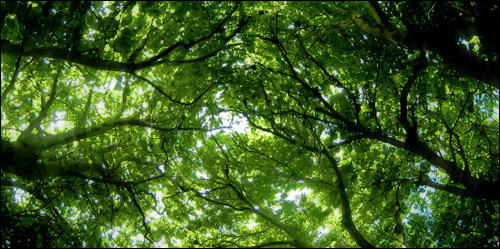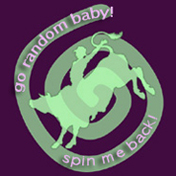Thu 30 Jul 2009
Space – The Final Front Ear
Posted by anaglyph under DIY, Gadgets, Geek, Sound, Technology, Work
[17] Comments

Computers have become so powerful now that it is possible to do things that are quite mind boggling. I have no doubt that you’re all aware of what’s going on in the realm of digital image, but us sound dudes can do some pretty cool stuff too.
Let me tell you about convolution reverb.
It is a truth universally acknowledged that no matter what your level of vocal talent, you will always sound better singing in the shower. The technical reason for this is that bathrooms have nice shiny reflective tile surfaces, and the reverberation off those surfaces allows you to hear your voice more clearly. ((It’s pretty hard to ‘hear’ your own voice in your head. When you sing, you are using reflections off the space in which you happen to be to judge your pitch – this is the reason that people often sing out of tune when they’re listening to music in headphones.))
It follows logically, then, that if you sound good in the shower, you’ll sound really good on stage at, say, the Sydney Opera House, with all its great reverberant reflections and acoustic properties. Of course, it’s not possible for you or me just to whip up an a capella version of Copacabana on the Sydney Opera House stage on a whim… or, at least it hasn’t been possible until now! Yes folks, not only can you now hear how your best Barry Manilow impersonation would sound onstage at the Sydney Opera House, but we can precisely simulate your performance in any acoustic space – caverns at Carlsbad… Wembley Stadium… Abbey Road studios… in a glass jar, a metal bucket or even a broom cupboard (where Barry Manilow would, arguably, sound most appropriate).
All this thanks to fast computer processing and ‘convolution’ mapping of acoustic spaces (stick with me folks, it’s pretty damn cool…)
As I’ve already mentioned, we gauge the details of the sound of a room by the reflections off surfaces in that room. Our ears are able to hear very small variations in frequency, and our brains, by comparing the information from one ear with the other, determine the exact aural characteristics of the environment we’re in. Quite obviously, every acoustic space is completely unique – it has an acoustic ‘fingerprint’ if you like – and we are able to very accurately judge aspects such as size, shape, harmonic frequencies and surface qualities of our surroundings. All this happens completely automatically of course – you don’t think ‘Ooh, I’m in a room thirty metres long with a fundamental harmonic frequency of 160Hz and plasterboard walls!’, but rather ‘This is a big hollow space!’ or ‘This is a cupboard!’
So, how does that become useful? When we record instruments of voices in a studio, we mostly strive to get the ‘cleanest’ most unaffected-by-the-environment recording we can, so that we may add acoustic effects such as reverberation and delay at some later date. This is done for two reasons – one is that any reverberant characteristics originally recorded with an instrument are ‘stuck’ to it – you cannot remove them. A flute recorded in a big church will always sound full and awash with reverb – nine times out of ten, that’s not desirable. The second reason that we prefer a ‘clean’ recording, is that we can apply reverb and other effects judiciously as we need, to make for a better and more pleasing balance in the audio mix.
When it comes to music recording and film sound, then, you can understand that being able to call up particular audio characteristics on demand has significant value. Up until now we’ve relied on artificially created approximations of real environments – good enough to fool your ear, but nothing like the real thing. Now, we can get so close to the real thing that even experts have trouble picking the difference. In other words, we can now use on our recordings the beautiful, real, rich ambiences that have been created in performance spaces and studios around the world. Or, if we need to, the sound spaces of interior cars, hallways, schoolrooms, water towers, aircraft hangars or jam jars – you can see how we film people might like that kind of thing.
So how is this impressive audio magic done? Well, if I don’t go into too much technical detail, it’s actually quite simple. We take a sound – optimally a tone sweep ((This is basically a sound that starts off really low in pitch and ‘sweeps’ to really high over a few seconds. A sharp transient sound like a pistol shot, or an electrical spark or a balloon pop can also be used – hence the term impulse response that you’ve heard me use.)) – and play it in the environment we want to model, re-recording it in high quality within the acoustics of that place. Then, using some fancy software, we compare that with a ‘pure’ version of the tone sweep. The software calculates the difference between the two sounds and uses that to build a map of the frequency responses and delays of the actual space. It takes my computer about a second to process the file – incredible. From this I get a ‘convolution map’ that I can then use in my audio software to apply to any other sound.
As I mentioned in my most recent post about Masthead Island, the Pisonia forest in the middle of the island had some very nice acoustic characteristics. I wasn’t able to take up equipment for making tone sweeps, but I recorded some ‘make-do’ resonses with sharp hand claps.
So, after such an exhausting technical lesson, I know you’ll want to hear some demonstrations of what I’ve been yammering about, and, lucky for you, I have prepared some earlier! So first of all, we need to start with our source sound, and I’m sure you’re way ahead of me with what that might be…
1. Here we have a duck’s quack as you might hear it in a field, with no acoustic reflections:
Download Raw Duck
2. Now, a duck as you might have heard it in the Pisonia forest on Masthead Island:
Download Forest Duck
3. Next, a duck on stage at the Sydney Opera House (as you might hear it from the stalls):
Download What’s Opera Duck?
4. And finally, a duck recorded in a washing machine just before you throw the spin cycle switch:
Download Washed Duck
There were, alas, no actual ducks on Masthead Island, but I can assure you, if there were, they would sound much like #2 above.
So, faifthful Acowlytes, that’s the TCA Crash Course in convolution spatial mapping. Your task for this week is to listen. That’s it: simply listen. As you walk about your daily lives, listen to the way your voice sounds in different rooms. Listen to the ambience on the street as sirens sweep by. Listen to yourself singing in the shower. Listen to how the sound of your voice changes as you walk from one room to another.
And marvel with me that we can now reproduce the acoustics of all those experiences exactly.




I’m glad you used those cryogenically frozen cables on the duck Rev, it makes it sound sooo much better.
Where’s the sound of the rifle at the end though, did you edit if off for the vegetarians?
The King
Oh dear, I just vagued out and then listened to the quacking (happens a lot around the castle).
which one is on the menu at Phat Duck?
King Willy: I only use organic free range cables on my ducks, King Willy – you should know that!
Pil: Quack.
Nurse Myra: Not the one in the washing machine I hope. It might taste a bit sudsy.
You know, the Soviets used to multitask by using underground nuclear bomb testing to get deep seismic sounding (DSS) surveys.
I find it interesting, really, just how much MORE information can be gleaned from something like sound radiation bouncing around and returning to your ear than light bouncing around and hitting your eye. Especially considering how sight dependent we are.
I think most people have probably thrown a rock down a hole to see how deep it was if they couldn’t see the bottom.
Being a sound person by training (and by nature I figure) it’s disappointing to me how much people miss about the sound world. For a start, sound is a much more direct conduit to the emotions that vision (and scent is even more direct in that respect).
I sometimes take students on a ‘critical listening skills’ test where we go somewhere such as a shopping mall or an airport and I get them to write down everything they can hear. On average, my list is twice as long as anyone in the class. They miss the most obvious things – footsteps; voices; music and more often than I would have thought, PA announcements (so there’s some work for a process management psychologist). So even with focussed listening, sound students aren’t hearing everything in the world.
There’s a good reason for it, of course – our brain has a whole subsystem in charge of allowing you NOT to listen to things, in order that you don’t become overwhelmed with audio information.
But sound, and the way it works on our psychology, is a rich deep topic that has many absorbing facets. If you choose it for a profession, just don’t expect anyone to take the time to listen to what you have to say.
I believe the reverb effect in churches was designed to enhance the “Altar Boy Experience” or ABE as it’s affectionately known in the clergy.
Something about the screams lasting longer I guess…
The King
hewhohears: Well, in fact, big reverberant spaces date well back into history, and were not necessarily used for religious reasons. The ancient Greeks, for example, had a pretty good understanding of acoustics, and many theatres and amphitheatres were designed expressly to enhance the music or vocal performances played in them.
There is even speculative science that suggests that in prehistoric times caves and caverns were selected on the basis of their acoustic properties – I’m sure the local tribe leader pretty quickly discovered that he sounded much more impressive when he spoke from the rock in Dead Mammoth Cave.
King Willy: Tsk.
God, you’ve got all serious since you’ve got back Rev, and since Joey and Atlas got their room, well, think I’ll head over to Gimcrack then for a bit of friday fun.
Thhhheeeeeee Kiiiinnnngggggg
I wonder exactly how much (completely unscientifically quantifiable) of your daily emotional life is in response to your acoustic environment. I’ve noticed that when people walk into a big, enclosed space, they have a tendency to shut up. It doesn’t matter whether it’s a cave, a crazy ass rock formation, or a church. I’ve also noticed that in some people, they get a crazy compulsion to howl or yell when they find themselves looking into some great open space, such as off a mountain peak or off a high bridge.
Preachers, I’ve noticed, respond to changes in sonic environment. A mic’ed preacher has a completely different delivery, usually with over the top emotion, compared with one relying on natural acoustics. Even the same preacher varies from place to place. I can think of some pretty wild sermons under the arbor at camp meetings that would never have happened in the stifling little one room churches we were used to.
Now that would be an interesting take on a psychologically stimulating sonic environment: a high roof, no walls, central fire pit, concentric rings of pews–filled, and a forest outside.
So we may actually be able to hear the difference between, say, the same violin played at our own Boston Symphony Hall vs. some other great halls and compare them? Astounding. And then there will be the new cd- “Liberace’s Greatest Hits -the Rinse Cycle Tapes”, coming soon…
King Willy: It’s all about contrasts.
Casey: Few people stop and think for a even a moment about how the sound of their world influences their lives and their emotions. Hence the point of this week’s Cow Task. I’ll bet no-one even did it.
Colonel: Yes – if you were a violin player, you could conceivably ‘test run’ your performance at a place you’d never been.
As for Liberace, the washing machine could only make him sound better. Cleaner at least.
In fact, I wonder if you played grunge music in a washing machine if it would come out like FM pop?
car tires swishing .. clap of pigeon wings … tweet tweet … laptop keys … air in my nose … vroom … (small urban apartment, windows open, day)
MMMMMMMMMM – Duck
Actually I have to disagree with the line: And marvel with me that we can now reproduce the acoustics of all those experiences exactly.
Perhaps ‘very closely’ would be a better term here Rev, it’s close, but only as far as the current algorithm gets us…
The King
Cissy Strutt: Go to the top of the class. And isn’t the world better for the noticing?!
Malach: Stop peking.
King Willy: Oh yes, picky picky picky. By relative incremental measurements, it’s closer to ‘exactly’ than a spring reverb will every get you.
Oh, I did, but no more than I usually do. Coffee shops have been fascinating me lately.